Last Updated on December 22, 2023 by
On the many trips to Rajasthan, especially around Udaipur, I had always wanted to visit the Ranakpur Jain Temple because of its exquisitely ornamented interiors with sculptures in marble.
Ranakpur should be on the list when planning a Udaipur itinerary. Ranakpur is only 100 km from Udaipur and certainly deserves a one day trip.
During my visit to Jawai Leopard Safari in Rajasthan, I decided to spend an afternoon seeking the blessings of Shree Parshwanath Swami at the Jain temple of Ranakpur.
A visit to Ranakpur is generally combined with a visit to Kumbhalgarh – second longest wall in the world. But, since my trip to Kumbhalgarh was already done, we drove back to Ahmedabad from Jawai via Ranakpur.
Ranakpur Jain Mandir is one of the most important Jain temples in Jainism and ranks in the list of top 5 holy shrines of Jains. Ranakpur Jain temple is the largest Jain temple in India.
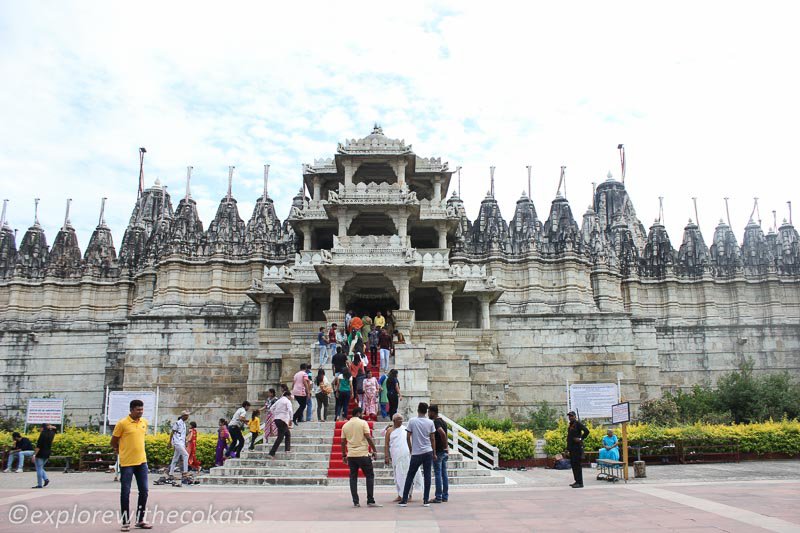
Table of Contents
History of Ranakpur Jain Temple
In the 14th century, a local businessman Dharna Shah had a celestial vision of Adinath, the founder of the Jain religion. The vision was about temple construction. Without wasting any time he approached the then Rajput king Rana Kumbha for permission and support to build a temple to honour the great Saint Adinath.
After procuring the land and permission for temple construction, Dharna Shah went through many design proposals so that at least one matched his vision. The design submitted by an architect and chief sculptor was of Deepak. The initial plan was to build a seven-storied high temple. But even after 50 years, only three floors were made, that too was incomplete. After the installation of the idol of Adinath, the construction went on for 15 more years and was completed in the 15th century.
The Mughal army attacked the temple in the 17th century but the priests of the temple hid the main statues in the cellar of the temple. So, thankfully they were spared.
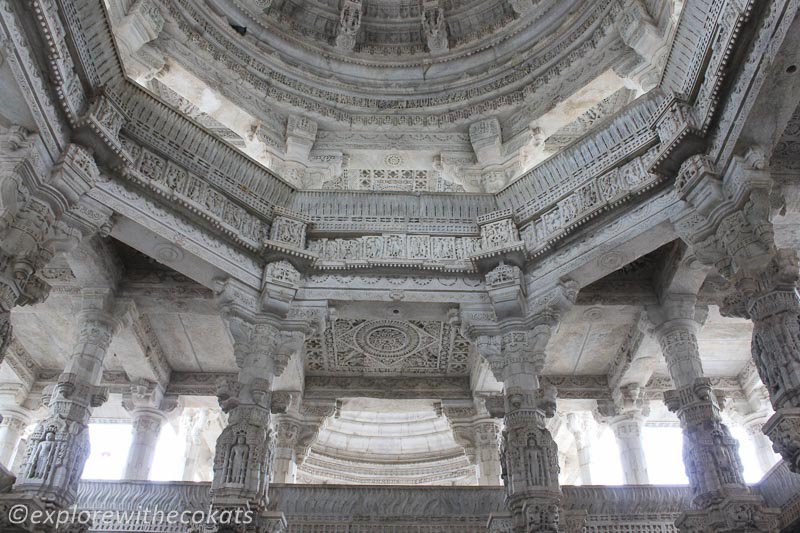
The architecture of Ranakpur Jain Temple
Ranakpur Jain temple is made of white marble and is situated on the foothills of Aravallis. It is spread across 48,000 square feet and is known for its intricacy and beautifully carved 1444 pillars, 426 columns, 89 domes, and 29 halls. It also has 84 underground chambers that were built to hide Jain idols in case of an attack.
The temple is built in the Maru-Gurjara style architecture, a style that is quite prevalent in the western states of India. The Rani-ki-vav, Patan is also built in this style.
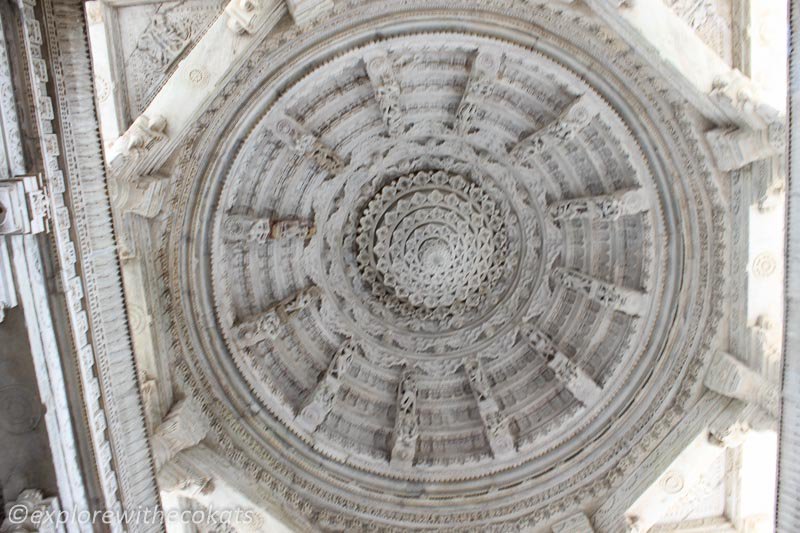
Chaturmukh temple
Chaturmukh is the main temple in Ranakpur. This is the main shrine after the visitors descend from the steps. The idol sits on a huge raised platform, supported by numerous pillars. There are 4 entrances to the main chamber of the temple. Inside there are 4 huge, 6ft. tall, sparkling white marble idols of Saint Adinath. All are facing 4 different directions.
On the 2nd and 3rd floors, there are shrines housing 4 identical Jain Gods. The temple, therefore, is also called Chaturmukh Jain Temple.
The temple has distinctive domes, flags over the domes, shikhara, turrets and cupolas. In the garbhagriha, there is a 6-feet tall, white-coloured chaumukha idol of Adinath with four heads facing in four directions. The temple is famous for its beautiful carved idol of Parshvanatha made out of a single marble slab. The idol has 1008 snakeheads and numerous tails.
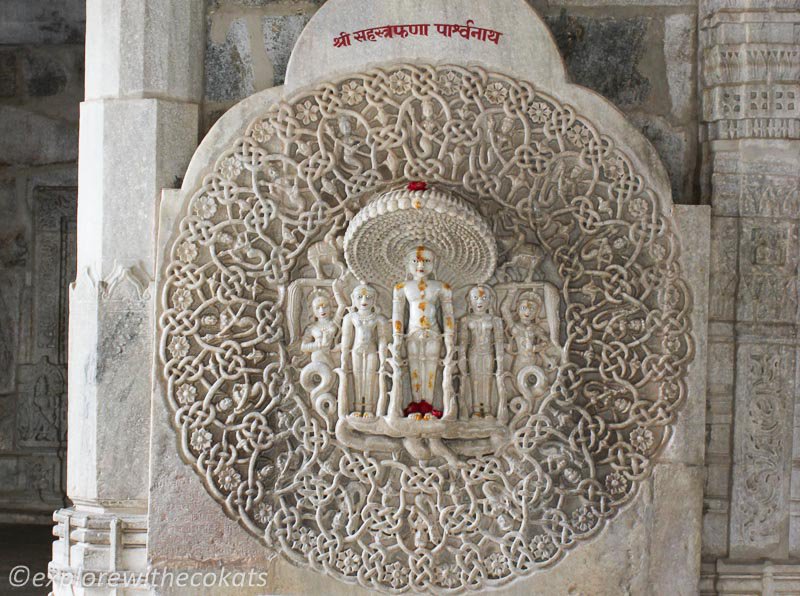
Unique pillars of Ranakpur Jain Temple
The entire weight of the magnanimous temple structure rests on intricately carved 1444 pillars. None of the pillars has the same design making it awe-inspiring. The unique feature of the pillar is that in spite of so many pillars, the sighting of the main idol is not restricted from any angle. The area is extremely well ventilated and cool with the passage of wind.
Another amazing feature is that the colour of the pillars changes throughout the day depending upon the angle of sunlight and time of the day. The colour ranges from golden to orange to blue that the marble reflects.
I could not help but crane my neck to see the incredible ceiling. There are over 80 domes with intricate carvings done in marble even on the ceiling.
Also Read: Chennakesava Temple Somnathpura that has mind-blowing sculptures.
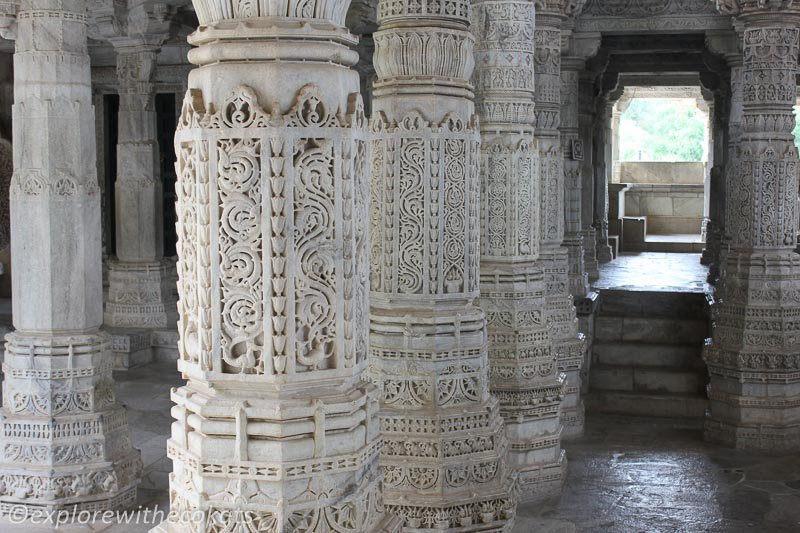
Decorated Arches
There were hundreds of decoratively sculptured arches in the temple, locally known as Toran. All the torans were carved out from a single stone. Unfortunately, after the Mughal attack, only three such orans exist today. These torans certainly reminded me of the Kirti Toran at Vadnagar.
Elephant sculpture in Ranakpur Jain Temple
One cannot miss the many sculptures of elephants in the temple. One of the elephant sculptures in the main hall is particularly of importance. As per a legend, by crawling under the belly of this elephant, the person’s wishes get completed.
Don’t be surprised to see people of all ages trying their luck by ducking under this elephant.
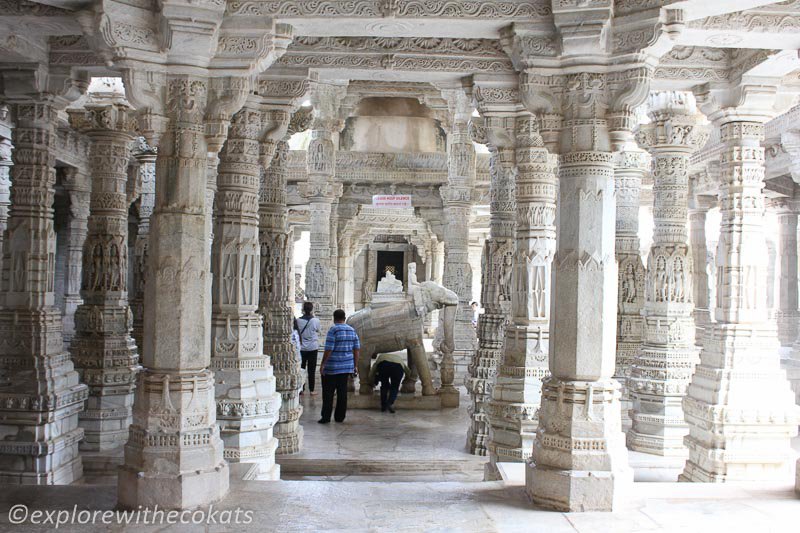
Revival of Ranakpur Temple
I can’t imagine the real beauty of the temple before the Mughal attack happened. Alas, the original beauty lasted only for 200 years! Thankfully, its revival was undertaken by Shri Kasturbhai Lalbhai, the chief of Sheth Anandji Kalyanji Trust. With over 200 workers and artisans, he dedicated himself to the reconstruction of Ranakpur Mandir.
One can easily distinguish between the old and new sculptures that can be seen by colour differentiation.
Practical tips for visiting Ranakpur Jain Temple
Best time to visit Ranakpur Temple
The Somanathapura temple timing is 6:30 am to 8:00 pm and it is open on all days of the week. It is ideal to visit it in the early morning to avoid crowds and heat.
The best time to visit the Jain temple is in the winter (November – March). Summers could be difficult for visitors due to heat. Monsoon would still have humidity and make the visit uncomfortable.
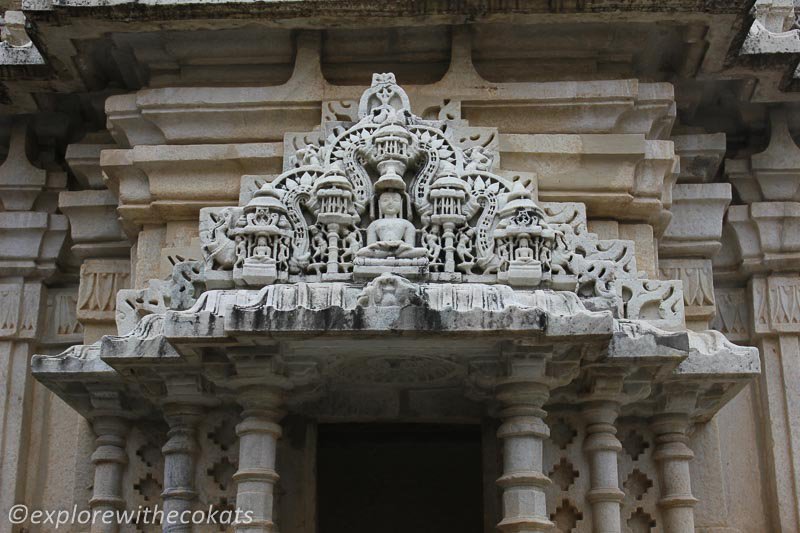
Entry Fee to Jain Temple of Ranakpur
Like all other Jain temples, entry is free to Ranakpur Jain temple.
How to Reach Ranakpur Jain temple | Ranakpur temple location
The location of Ranakpur Jain Mandir Pali is in the Pali district of Rajasthan. Ranakpur does not have an airport but due to its close proximity to Udaipur, it can be easily reached.
By flight
Dabok Airport in Udaipur is the nearest domestic airport that has frequent flights to Delhi and Mumbai. From Udaipur, one can book a seat in government-run buses, private buses or private taxis.
By train
The nearest railway station is Udaipur Railway Station. Udaipur is well-connected with other cities of Rajasthan as well as India. There are frequent trains that run to and from Udaipur connecting Ahmedabad, Jaipur, Mumbai and Delhi.
By road
Ranakpur Jain Temple can be easily added to road trips between Jodhpur and Udaipur. Buses to Ranakpur can be taken from the main bus stand at Udaipur.
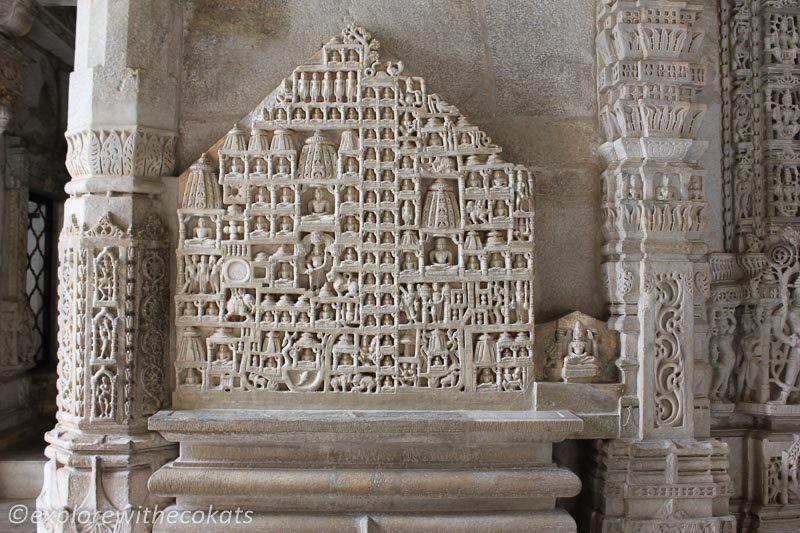
Hotels in Ranakpur: Where to stay
While there is a Jain Dharamshala that offers rooms to stay for travellers, on the temple premises, the rooms tend to be sold out frequently. You can check here. The non-air-conditioned room tariff begins from Rs. 300 per person. Although a visit to Ranakpur is a one day trip from Udaipur, in case you wish to stay in Ranakpur, there are many options.
Resorts: WelcomHeritage Maharani Bagh Orchard Retreat, Hotel Aranyawas
Hotels: Lal Bagh, Fatehbagh – A Heritage Rennaissance
Homestay: Naval Baug Homestay, Rajpura Bungalow
Where to eat in Ranakpur
On the temple premises, there is a Ranakpur Tirth Bhojanshala that serves Jain food (without onion and garlic) three times a day. Breakfast is available from 7 am to 8:30 am lunch from 12 noon to 1:30 pm and dinner from 5 pm to 5:30 pm. Breakfast donation per person is Rs. 30 while for lunch and dinner is Rs. 60. The times are quite strict in case you want to have lunch here.
There are many roadside eateries and restaurants in Ranakpur serving snacks and meals all day long.
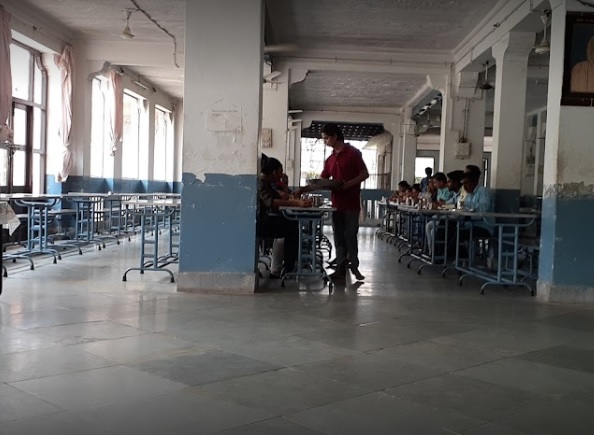
Places to visit near Ranakpur
Kumbhalgarh Fort
Kumbhalgarh fort like the many forts is a must-visit attraction in Rajasthan. Being near Udaipur, it is a popular choice for tourists.
Golden Temple, Falna
The Jain Golden Temple in Falna, a small town in Rajasthan has a unique attraction worldwide. It is the first temple that has been constructed by the people of the Jain community wherein the ladies of this village donated 90 kg for the idolization of the temple dome and Lord’s idol.
Sun Temple Lohargal
Sun Temple of Ranakpur is dedicated to the Surya Narayan god. This 13th-century temple was rebuilt in the 15th century after its destruction. Sun temple is built with white limestone in Nagara style with delicate ornamented work. Read more on sun temples: Modhera Sun Temple and Konark Sun Temple.
Sustainable travel tips for Ranakpur Jain temple
- Being an ancient temple, respect the structures by not sitting on them or drawing on them.
- Like every Hindu temple, devotees are not allowed to wear footwear. Please remove footwear outside the temple.
- Do not enter places that are closed off, and always follow the directions given by the temple security.
- Throw your garbage in the dustbins located at the entrance of the temple.
- Be respectful and be quiet as there are multiple signages everywhere suggesting the same. If you must speak, keep your voice very low.
Read More Temple posts with Intricate Sculptures:
- Mahakuta Temples of Karnataka
- Trimbakeshwar Temple, Nashik
- Badami Cave Temples of Karnataka
- Aihole Temple
Read More Posts from Rajasthan:
- Panna Meena ka Kund, Jaipur
- Places to visit near Eklingji Temple
- Must buy souvenirs from Jaipur
- Anokhi Museum, Jaipur
- 3 days Jaipur itinerary
Disclaimer: This article includes affiliate links. It means it adds no extra cost to you if you book through the link but I get a referral bonus which helps me earn a little to keep this website up and running.
Pin this post!
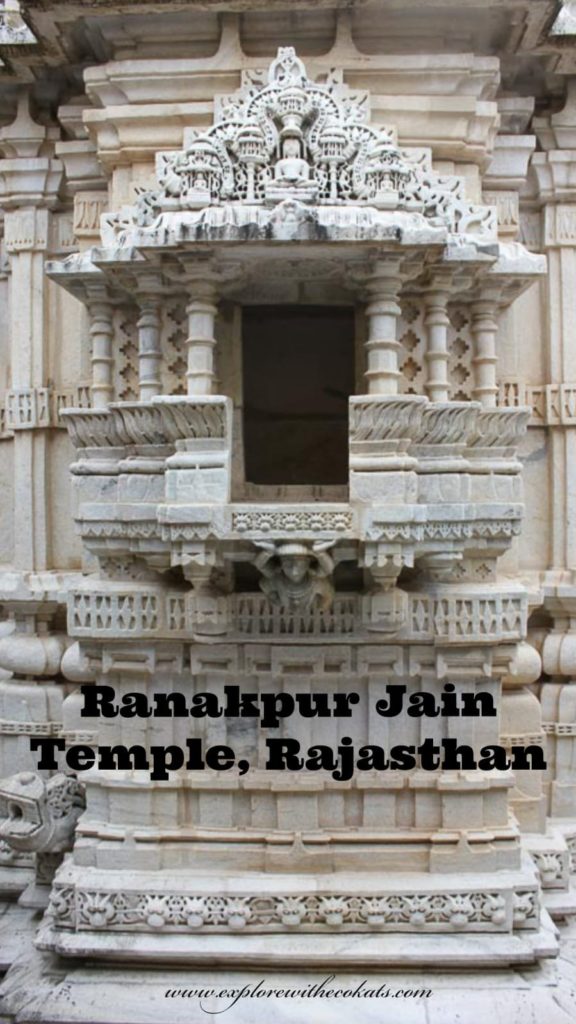

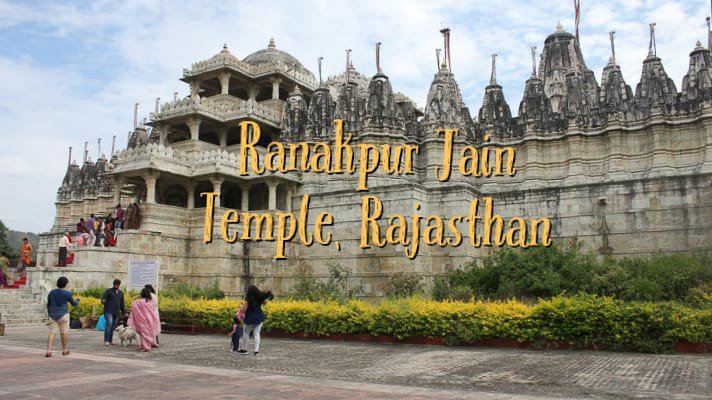
5 comments
Wow, the detail on the Pillars of Ranakpur Jain Temple, Pali, Rajasthan are just awe inspiring. I love your trip details and information. Thank you for sharing!
Wow! That is indeed a stunning temple. Being a Jain myself, I did not know about this temple. Thank you for sharing it. My father is going to love this post.
Wow! This is indeed a stunning temple! I love all the small details on everything, seems that they had an eye for details back then. Would love to visit it! 🙂
This temple looks absolutely stunning to visit. The intricate carvings in the stones are incredible.
I love learning about architecture when I visit a new country or region. This is fascinating. Your photos are amazing.